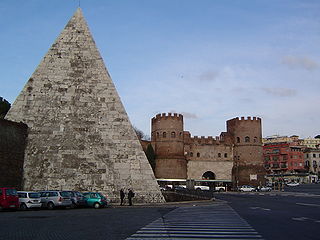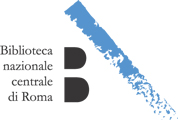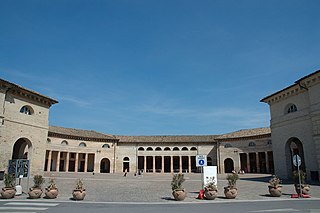
Trastevere is the 13th rione of Rome, Italy. It is identified by the initials R. XIII and it is located within Municipio I. Its name comes from Latin trans Tiberim.

Montepulciano is a medieval and Renaissance hill town and comune in the Italian province of Siena in southern Tuscany. It sits high on a 605-metre (1,985 ft) limestone ridge, 13 kilometres (8 mi) east of Pienza, 70 kilometres (43 mi) southeast of Siena, 124 kilometres (77 mi) southeast of Florence, and 186 kilometres (116 mi) north of Rome by car.

Ponte is the 5th rione of Rome, Italy, identified by the initials R. V, and is located in Municipio I. Its name comes from Ponte Sant'Angelo, which connects Ponte with the rione of Borgo. This bridge was built by Emperor Hadrian in 134 AD to connect his mausoleum to the rest of the city. Though Pope Sixtus V changed the rione limits, so that the bridge belongs now to Borgo, not to Ponte anymore, the area has kept its name and a bridge as its coat of arms.

Sant'Eustachio is the 8th rione of Rome, Italy, identified by the initials R. VIII. It is named after the eponymous church and is located within the Municipio I.

Regola is the 7th rione of Rome, Italy, identified by the initials R. VII, and belongs to the Municipio I. The name comes from Arenula, which was the name of the soft sand that the river Tiber left after the floods, and that built strands on the left bank.

Borgo is the 14th rione of Rome, Italy. It is identified by the initials R. XIV and is included within Municipio I.

Testaccio is the 20th rione of Rome, Italy, identified by the initials R. XX, deriving its name from Monte Testaccio. It is located within the Municipio I.

The Basilica of St. Augustine in Campo Marzio, commonly known as Basilica of St. Augustine and Sant'Agostino, is a Roman Catholic titular minor basilica dedicated to Saint Augustine of Hippo. It is the mother church of the Order of Saint Augustine and it is located just northeast of the Piazza Navona in the rione of Sant'Eustachio in Rome, Italy.

Giles Antonini, O.E.S.A., commonly referred to as Giles of Viterbo, was a 16th-century Italian Augustinian friar, bishop of Viterbo and cardinal, a reforming theologian, orator, humanist and poet. He was born in Viterbo and died in Rome.

Rocca di Papa is a small town and comune (municipality) in the Metropolitan City of Rome, Lazio, Italy. It is one of the Castelli Romani about 25 kilometres (16 mi) southeast of Rome on the Alban Hills. It is close to the other communes of Velletri, Rocca Priora, Monte Compatri, Grottaferrata, Albano and Marino. It is the center of the Regional Park known as the "Parco Regionale dei Castelli Romani".

Angelo Rocca was an Italian humanist, librarian and bishop, founder of the Angelica Library at Rome, afterwards accessible from 1604 as a public library.

The Biblioteca nazionale centrale di Roma, in Rome, is one of two central national libraries of Italy, along with Biblioteca Nazionale Centrale di Firenze in Florence. In total, 9 national libraries exist, out of 46 state libraries.

The Biblioteca Vallicelliana is a library in Rome, Italy. The library is located in the Oratorio dei Filippini complex built by Francesco Borromini in Piazza della Chiesa Nuova.

The Patristicum, officially the Augustinian Patristic Pontifical Institute, is a pontifical institute in Rome, under the supervision of the Order of Saint Augustine. It is an incorporated institute of the Pontifical Lateran University. It is responsible for the study of patristic theology, the history and theology of the Church Fathers.

Porta Angelica was a gate of the Leonine Wall in Rome (Italy).

San Trifone in Posterula was an ancient titular church of Rome, now lost. It was located at the corner of Via dei Portoghesi and Via della Scrofa, in the Campo Marzio rione of the city.

Sant'Agostino is a Romanesque-Gothic-style Roman Catholic church located in Via Cairoli in Rimini, Italy. It is one of the city's oldest extant church buildings.

Piazza del Duomo is the main square of the city of Altamura, Italy. It is located in the center of the historic city center, as well as in the middle of the main street of the city, that is corso Federico II di Svevia. Moreover, Altamura Cathedral, the main church of the city, is located on the square. It is also known because the Tree of Liberty was planted in this square during the so-called Altamuran Revolution (1799).

The Megalithic Walls of Altamura are defensive walls dating back to the 4th century BCE. They were the city walls of the ancient city of Altamura, Italy. Nowadays, only a few parts of the original wall remain; the original track of the wall spanned over a length of about 3.6 km. They were about 4 meters high, while the base of the walls was about 5 meters wide.

The public library Antonelliana is the main library of the city of Senigallia (AN), also home to the historical archive of the city.




















